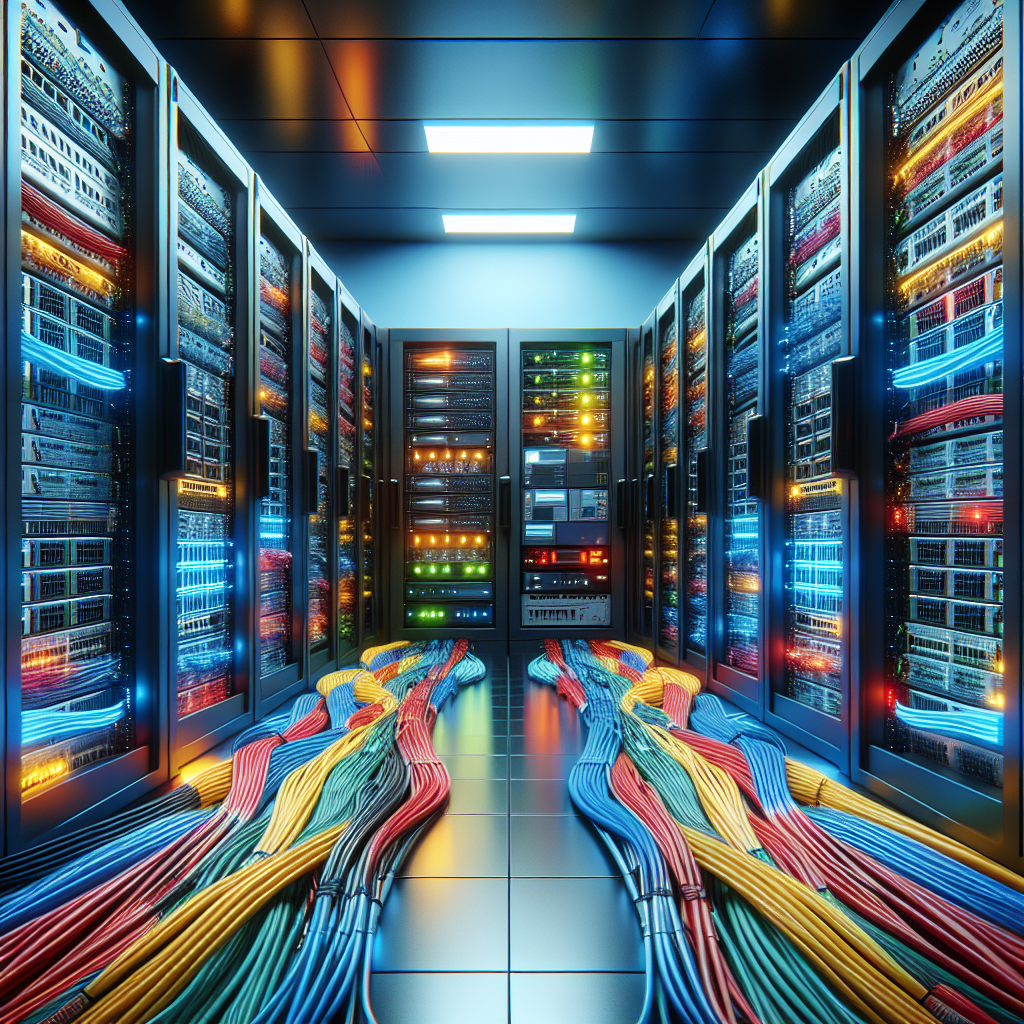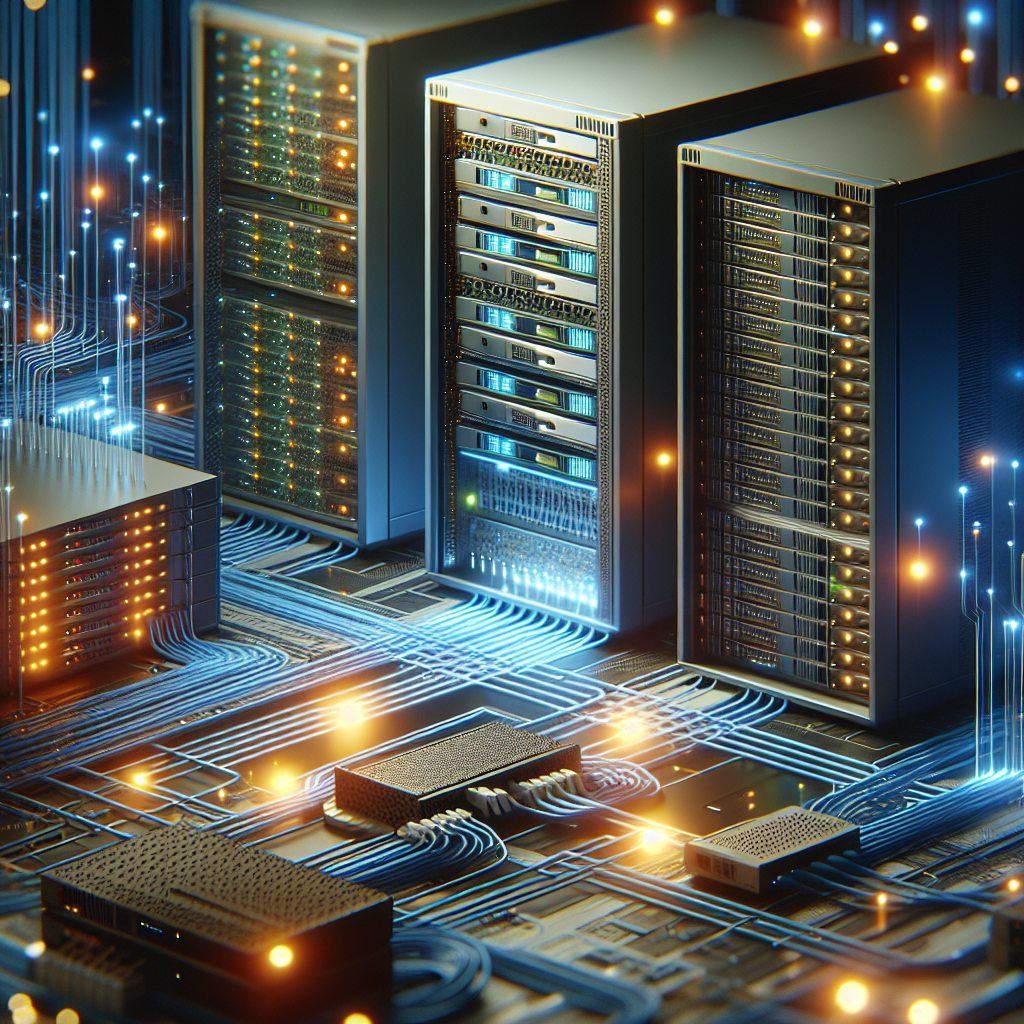Your cart is currently empty!
Tag: Network

Navigating the Challenges of Data Center Network Infrastructure Management
In today’s digital age, data centers play a crucial role in storing and managing vast amounts of data for businesses of all sizes. As the demand for data storage and processing continues to grow, the network infrastructure that supports these data centers must be able to handle increasing amounts of traffic and data flow. Navigating the challenges of data center network infrastructure management is essential for ensuring that data centers can operate efficiently and effectively.One of the biggest challenges in managing data center network infrastructure is scalability. As businesses grow and their data storage needs increase, data centers must be able to scale their network infrastructure to accommodate the additional data traffic. This can be a complex and time-consuming process, requiring careful planning and coordination to ensure that the network can handle the increased load.
Another challenge in data center network infrastructure management is ensuring high availability and reliability. Downtime in a data center can have serious consequences for businesses, leading to lost revenue and reputation damage. Network infrastructure must be designed and maintained to ensure maximum uptime and reliability, with redundant systems and failover mechanisms in place to minimize the risk of downtime.
Security is also a major concern when it comes to data center network infrastructure management. Data centers store sensitive and valuable information, making them prime targets for cyber attacks. Network security measures such as firewalls, intrusion detection systems, and encryption protocols must be implemented to protect data from unauthorized access and data breaches.
Managing the complexity of data center network infrastructure is another challenge that IT teams face. With multiple servers, storage devices, and networking equipment all interconnected, keeping track of all the components and ensuring they are all functioning properly can be a daunting task. Comprehensive network monitoring and management tools can help IT teams effectively manage and troubleshoot network issues in real-time.
In conclusion, navigating the challenges of data center network infrastructure management is essential for ensuring the smooth and efficient operation of data centers. By addressing scalability, reliability, security, and complexity issues, IT teams can ensure that data centers can meet the growing demands of businesses and provide the necessary support for storing and managing data effectively. With careful planning, monitoring, and management, IT teams can overcome the challenges of data center network infrastructure management and ensure that data centers operate at peak performance.

The Impact of Data Center Cabling on Network Performance: How to Improve Speed and Reliability
In today’s digital age, data centers play a crucial role in supporting the increasing demand for storage, processing, and networking capabilities. However, one often overlooked aspect of data center infrastructure is cabling – the physical layer that connects servers, storage devices, and networking equipment. The quality and design of data center cabling can have a significant impact on network performance, speed, and reliability.The way data center cabling is structured and organized can directly affect the efficiency and effectiveness of data transmission. Poorly organized cabling can lead to signal interference, data loss, and increased latency, all of which can degrade network performance and reliability. On the other hand, well-designed and properly installed cabling can optimize data flow, reduce latency, and improve overall network speed.
One of the key factors that influence data center cabling performance is the choice of cabling technology. Traditional copper cabling, such as Cat 5e and Cat 6, has been widely used in data centers for many years. While copper cabling is cost-effective and easy to install, it has limitations in terms of bandwidth and distance. As data center networks continue to grow in size and complexity, many organizations are turning to fiber optic cabling for its superior speed, bandwidth, and reliability.
Fiber optic cabling uses light signals to transmit data, allowing for faster and more efficient data transmission compared to copper cabling. Fiber optic cables also have a much higher bandwidth capacity, enabling data centers to support higher data volumes and faster data speeds. In addition, fiber optic cables are immune to electromagnetic interference, making them more reliable in high-density data center environments.
Proper cable management is another crucial factor in optimizing data center cabling performance. Well-organized cabling can reduce cable congestion, improve airflow, and facilitate easier troubleshooting and maintenance. Cable trays, racks, and labels should be used to ensure that cables are neatly organized and easily accessible. Regular cable maintenance and inspections should also be conducted to identify and address any potential issues before they impact network performance.
In addition to choosing the right cabling technology and implementing proper cable management practices, data center operators can also improve network performance by investing in high-quality cabling components and accessories. Quality connectors, patch panels, and cable testers can help ensure that cabling installations meet industry standards and perform optimally. Regular testing and certification of cabling infrastructure can also help identify any potential issues and ensure that the network is operating at peak performance.
In conclusion, data center cabling plays a critical role in the performance and reliability of network infrastructure. By investing in high-quality cabling technology, implementing proper cable management practices, and using quality components and accessories, data center operators can optimize network speed and reliability. As data center networks continue to evolve and grow, it is essential to prioritize cabling infrastructure to ensure that data can flow efficiently and securely throughout the network.

The Evolution of Data Center Network Infrastructure: Trends and Technologies
The data center network infrastructure has evolved significantly over the years, driven by the increasing demand for higher performance, scalability, and flexibility. In this article, we will explore the trends and technologies shaping the evolution of data center network infrastructure.One of the key trends in data center network infrastructure is the move towards software-defined networking (SDN). SDN allows for greater automation and programmability of network infrastructure, enabling organizations to quickly adapt to changing business requirements. By decoupling the control plane from the data plane, SDN simplifies network management and improves agility, scalability, and efficiency.
Another important trend is the adoption of fabric-based architectures in data center networks. Fabric-based networks use a high-speed, low-latency interconnect to create a unified, virtualized network infrastructure that can easily scale to meet increasing demand. These architectures provide greater flexibility and performance compared to traditional hierarchical network designs.
The rise of hyperconverged infrastructure (HCI) is also driving changes in data center network infrastructure. HCI combines compute, storage, and networking resources into a single, integrated system, simplifying deployment and management. To support HCI deployments, data center networks must be able to provide high-speed, low-latency connectivity between virtualized workloads and storage resources.
In terms of technologies, 25GbE and 100GbE Ethernet are becoming increasingly popular in data center networks. These high-speed Ethernet standards provide the bandwidth needed to support the growing volume of data traffic generated by modern applications and workloads. Additionally, technologies like remote direct memory access (RDMA) and non-volatile memory express (NVMe) over fabrics are being adopted to improve performance and reduce latency in data center networks.
Security is another key consideration in the evolution of data center network infrastructure. With the increasing threat of cyberattacks, organizations are implementing advanced security measures, such as microsegmentation, encryption, and threat detection and response capabilities, to protect their data and applications. These security technologies must be integrated into the network infrastructure to provide comprehensive protection against evolving threats.
In conclusion, the evolution of data center network infrastructure is driven by the need for higher performance, scalability, and security in modern data center environments. Trends such as SDN, fabric-based architectures, HCI, and high-speed Ethernet standards are reshaping the way organizations design and manage their networks. By leveraging these technologies and best practices, organizations can build a more agile, efficient, and secure data center network infrastructure to support their business needs.

Optimizing Performance: Enhancing Your Data Center Network Infrastructure
In today’s digital age, businesses rely heavily on their data center network infrastructure to support their operations. From storing sensitive information to hosting critical applications, a company’s data center plays a crucial role in ensuring smooth and efficient business processes. As technology continues to evolve, it’s essential for organizations to optimize their data center network infrastructure to keep up with the increasing demands of the digital landscape.Optimizing performance in a data center network infrastructure involves a strategic approach that focuses on enhancing speed, reliability, and scalability. By implementing the right tools and techniques, businesses can improve their network’s overall efficiency and productivity. Here are some key strategies for optimizing performance in a data center network infrastructure:
1. Upgrade hardware and software: One of the first steps in optimizing a data center network infrastructure is to ensure that the hardware and software being used are up to date. Outdated equipment can slow down network performance and lead to frequent downtime. By investing in the latest hardware and software updates, businesses can improve the speed and reliability of their network infrastructure.
2. Implement virtualization: Virtualization technology allows businesses to create virtual instances of servers, storage, and networking resources. By deploying virtualization in a data center network infrastructure, organizations can increase flexibility, scalability, and efficiency. Virtualization also helps reduce hardware costs and energy consumption, making it a cost-effective solution for optimizing network performance.
3. Use quality of service (QoS) tools: Quality of service tools allow businesses to prioritize network traffic based on the importance of the data being transmitted. By using QoS tools, organizations can ensure that critical applications receive the necessary bandwidth and resources to operate efficiently. This helps prevent network congestion and latency issues that can impact overall performance.
4. Implement network monitoring and management tools: Network monitoring and management tools provide real-time visibility into the performance of a data center network infrastructure. By monitoring key performance metrics, businesses can identify and address potential bottlenecks or issues before they impact operations. These tools also help IT teams proactively manage network resources and optimize performance.
5. Optimize network security: Security is a critical aspect of optimizing performance in a data center network infrastructure. By implementing robust security measures, such as firewalls, intrusion detection systems, and encryption protocols, businesses can protect their data and prevent unauthorized access. A secure network infrastructure helps ensure the confidentiality, integrity, and availability of critical information.
In conclusion, optimizing performance in a data center network infrastructure is essential for ensuring the smooth and efficient operation of a business. By upgrading hardware and software, implementing virtualization, using quality of service tools, and optimizing network security, organizations can enhance the speed, reliability, and scalability of their network infrastructure. With the right tools and techniques in place, businesses can stay ahead of the curve and meet the evolving demands of the digital landscape.

The Role of Data Center Network Infrastructure in Cloud Computing
Cloud computing has revolutionized the way businesses operate by providing a flexible and cost-effective solution for storing and accessing data and applications. At the heart of this technology is the data center network infrastructure, which plays a crucial role in ensuring the smooth and efficient operation of cloud services.The data center network infrastructure is the backbone of cloud computing, connecting servers, storage devices, and networking equipment to enable the seamless transfer of data between users and cloud services. This infrastructure is responsible for handling the vast amounts of data that are generated and processed in the cloud, ensuring that information is delivered quickly and securely to users around the world.
One of the key functions of the data center network infrastructure in cloud computing is scalability. Cloud services need to be able to handle fluctuations in demand, with the ability to quickly scale up or down as needed. The network infrastructure must be able to accommodate this dynamic nature of cloud computing, ensuring that resources are allocated efficiently and effectively to meet the needs of users.
Reliability is another critical aspect of the data center network infrastructure in cloud computing. Users expect their data and applications to be available at all times, without any downtime or interruptions. The network infrastructure must be designed with redundancy and failover mechanisms to ensure high availability and reliability, minimizing the risk of service disruptions.
Security is also a major concern in cloud computing, as sensitive data and critical applications are stored and processed in the cloud. The data center network infrastructure must implement robust security measures, such as encryption, firewalls, and access controls, to protect data from unauthorized access and cyber threats. By ensuring the security of the network infrastructure, businesses can trust that their data is safe and secure in the cloud.
In addition to scalability, reliability, and security, the data center network infrastructure in cloud computing also plays a crucial role in performance. The network must be able to handle the high volumes of data traffic generated by cloud services, delivering fast and responsive performance to users. By optimizing the network infrastructure for speed and efficiency, businesses can provide a seamless and enjoyable user experience in the cloud.
In conclusion, the data center network infrastructure is a vital component of cloud computing, enabling businesses to leverage the benefits of this technology to store and access data and applications in a flexible and cost-effective manner. By focusing on scalability, reliability, security, and performance, businesses can build a robust network infrastructure that supports their cloud computing needs and ensures the success of their digital transformation initiatives.

Securing Your Data Center Network Infrastructure: Best Practices and Considerations
With the increasing number of cyber threats and data breaches, securing your data center network infrastructure has become more important than ever. Data centers store and process large amounts of sensitive information, making them prime targets for hackers. In order to protect your data center network infrastructure, it is crucial to implement best practices and considerations to ensure the security of your data.One of the first steps in securing your data center network infrastructure is to implement a strong firewall. Firewalls act as a barrier between your internal network and external threats, allowing you to control and monitor incoming and outgoing traffic. By setting up strict firewall rules, you can prevent unauthorized access to your data center network and reduce the risk of potential attacks.
Another important aspect of securing your data center network infrastructure is to regularly update and patch your systems. Outdated systems are more vulnerable to security threats, as hackers often exploit known vulnerabilities to gain access to your network. By keeping your systems up to date with the latest security patches, you can minimize the risk of attacks and ensure the protection of your data center network infrastructure.
Implementing strong access controls is also essential in securing your data center network infrastructure. By restricting access to sensitive information and resources, you can prevent unauthorized users from accessing your data center network. This can be done through the use of passwords, biometric authentication, and multi-factor authentication to ensure that only authorized users can access your network.
Regularly monitoring and auditing your data center network infrastructure is another important best practice in ensuring security. By monitoring network traffic and activities, you can detect any unusual behavior or potential security threats. Auditing your network infrastructure can help you identify any vulnerabilities or weaknesses that need to be addressed to enhance the security of your data center network.
In addition to these best practices, it is also important to consider physical security measures to protect your data center network infrastructure. This includes implementing access controls, surveillance cameras, and alarms to prevent unauthorized access to your data center. By combining physical and network security measures, you can create a comprehensive security strategy to protect your data center network infrastructure from potential threats.
Securing your data center network infrastructure requires a proactive approach to ensure the protection of your sensitive information. By implementing best practices and considerations, you can enhance the security of your data center network infrastructure and minimize the risk of cyber attacks and data breaches. Investing in strong security measures is essential in safeguarding your data center network infrastructure and maintaining the trust of your customers and stakeholders.

Scaling Up: Strategies for Growing Your Data Center Network Infrastructure
As businesses continue to rely more on digital services and applications, the demand for scalable and reliable data center network infrastructure is at an all-time high. With the exponential growth of data being generated and processed, organizations must have a robust and flexible network infrastructure in place to support their operations and meet the needs of their customers.Scaling up a data center network infrastructure involves implementing strategies and technologies that allow for seamless expansion and increased capacity. By effectively scaling up, organizations can ensure their network can handle the growing volume of data and traffic, while also maintaining high performance and reliability.
One key strategy for scaling up a data center network infrastructure is to invest in high-performance networking equipment. This includes routers, switches, and other hardware that can handle the increased traffic and bandwidth requirements. Upgrading to the latest technology and ensuring that the equipment is properly configured and optimized can help improve network performance and scalability.
Another important aspect of scaling up a data center network infrastructure is implementing a scalable network architecture. This involves designing the network in a way that allows for easy expansion and growth without causing disruptions to existing operations. By using technologies like virtualization, software-defined networking (SDN), and network function virtualization (NFV), organizations can create a more flexible and agile network infrastructure that can adapt to changing business needs.
In addition to upgrading hardware and implementing a scalable network architecture, organizations should also focus on network security when scaling up their data center network infrastructure. With the increasing number of cyber threats and attacks, it is essential to have robust security measures in place to protect sensitive data and ensure the integrity of the network. This includes implementing firewalls, intrusion detection systems, encryption, and access controls to prevent unauthorized access and data breaches.
Furthermore, organizations should consider implementing network monitoring and management tools to help optimize performance and identify potential bottlenecks or issues. By continuously monitoring the network and analyzing performance metrics, organizations can proactively address any issues and ensure that the network is operating at peak efficiency.
In conclusion, scaling up a data center network infrastructure is essential for organizations looking to support their growing data and traffic demands. By investing in high-performance networking equipment, implementing a scalable network architecture, prioritizing network security, and using monitoring and management tools, organizations can create a robust and flexible network infrastructure that can support their operations and future growth.

Key Components of a Reliable Data Center Network Infrastructure
A reliable data center network infrastructure is crucial for the smooth operation of any organization’s IT systems. Without a strong and dependable network, data transfer speeds can slow down, leading to decreased productivity and potential downtime. In order to ensure that your data center network is reliable, there are several key components that must be in place.1. Redundant Network Connections: One of the most important components of a reliable data center network infrastructure is redundant network connections. This means having multiple connections to the internet and other networks, so that if one connection fails, traffic can be rerouted through another connection. Redundancy is essential for ensuring that data can continue to flow even in the event of a network outage.
2. High-Speed Network Switches: Network switches are responsible for directing traffic between devices on a network. In a data center environment, high-speed network switches are essential for ensuring fast data transfer speeds and low latency. Look for switches that support high bandwidth and low latency to ensure that your network can handle the demands of your organization.
3. Scalable Network Architecture: As your organization grows, your data center network infrastructure needs to be able to scale to accommodate increased traffic and data transfer needs. A scalable network architecture allows you to easily add new devices and connections to your network without causing disruptions to existing services. Look for network equipment and technologies that are easily scalable to meet the evolving needs of your organization.
4. Network Security Features: Data security is a top priority for any organization, and a reliable data center network infrastructure must have robust security features in place. This includes firewalls, intrusion detection systems, and encryption protocols to protect data as it travels across the network. Regular security audits and updates are also essential to ensure that your network remains secure against the latest threats.
5. Monitoring and Management Tools: To ensure that your data center network infrastructure is running smoothly, it is important to have monitoring and management tools in place. These tools allow you to track network performance, identify bottlenecks, and troubleshoot issues in real-time. Look for network monitoring software that provides detailed analytics and alerts to help you proactively manage your network infrastructure.
In conclusion, a reliable data center network infrastructure is essential for the smooth operation of any organization’s IT systems. By ensuring that key components such as redundant network connections, high-speed network switches, scalable architecture, network security features, and monitoring tools are in place, you can create a network that is reliable, secure, and able to meet the evolving needs of your organization. Investing in a strong network infrastructure is crucial for ensuring that your organization’s data remains secure and accessible at all times.

Troubleshooting Data Center Network Connectivity Issues
Data centers are the backbone of modern businesses, housing critical infrastructure and data that keeps operations running smoothly. However, even the most well-designed and maintained networks can experience connectivity issues from time to time. When these issues arise, it is crucial to troubleshoot them promptly to minimize downtime and ensure that business operations can continue uninterrupted.There are several common causes of data center network connectivity issues, including hardware failures, misconfigured devices, network congestion, and software bugs. Identifying the root cause of the problem is the first step in troubleshooting connectivity issues. This can be done by conducting a thorough investigation of the network infrastructure, including switches, routers, firewalls, and servers.
One of the most common causes of network connectivity issues is hardware failures. This can include faulty network cables, malfunctioning network interface cards, or failing switches and routers. To troubleshoot hardware-related issues, IT professionals can conduct physical inspections of the network equipment, check for loose connections, and replace any faulty components as needed.
Misconfigured devices can also cause network connectivity issues. This can include incorrect IP addresses, subnet masks, or gateway settings. By reviewing the configuration settings of network devices, IT professionals can identify and correct any misconfigurations that may be causing connectivity problems.
Network congestion is another common cause of connectivity issues in data centers. This can occur when there is too much traffic on the network, leading to slow performance and dropped connections. To troubleshoot network congestion, IT professionals can monitor network traffic using tools like network analyzers and bandwidth monitoring software. By identifying the source of the congestion, IT professionals can take steps to alleviate the issue, such as implementing Quality of Service (QoS) policies or adding additional network capacity.
Software bugs can also cause network connectivity issues in data centers. This can include firmware bugs in network equipment or software bugs in applications running on servers. To troubleshoot software-related connectivity issues, IT professionals can update firmware and software patches, conduct system updates, and perform regular maintenance to ensure that all systems are running smoothly.
In conclusion, troubleshooting data center network connectivity issues requires a methodical approach to identify and resolve the root cause of the problem. By conducting thorough investigations, IT professionals can ensure that network connectivity is restored quickly and efficiently, minimizing downtime and ensuring that business operations can continue uninterrupted.

Future-Proofing Your Data Center Network Infrastructure
In today’s fast-paced digital world, data centers are the backbone of businesses, storing and processing vast amounts of information critical to operations. As technology continues to evolve, it’s imperative to future-proof your data center network infrastructure to ensure scalability, reliability, and security.Future-proofing your data center network infrastructure involves planning and implementing strategies to accommodate the growing demands of data and applications. Here are some key steps to consider:
1. Embrace software-defined networking (SDN): SDN allows for centralized network management and automation, making it easier to adapt to changing network requirements. By separating the control plane from the data plane, SDN enables more flexibility and agility in managing network resources.
2. Adopt virtualization: Virtualization technology allows for the consolidation of servers, storage, and networking resources, reducing hardware costs and improving resource utilization. Virtualized networks can easily scale to meet growing demands and can be provisioned and configured rapidly.
3. Invest in high-speed networking equipment: As data volumes continue to increase, high-speed networking equipment, such as 10G, 40G, and 100G switches and routers, will be essential to support the bandwidth requirements of applications and services. Upgrading to faster networking equipment will help ensure that your data center can handle future traffic growth.
4. Implement redundancy and failover mechanisms: Building redundancy into your network infrastructure is critical to ensuring high availability and fault tolerance. Redundant power supplies, network links, and network switches can help prevent downtime and ensure data center continuity in the event of a failure.
5. Enhance security measures: With the rise of cyber threats and data breaches, ensuring the security of your data center network infrastructure is paramount. Implementing firewalls, intrusion detection and prevention systems, encryption protocols, and access controls can help protect your data and infrastructure from malicious attacks.
6. Monitor and analyze network performance: Regularly monitoring and analyzing network performance metrics can help identify bottlenecks, optimize network traffic, and proactively address potential issues before they impact operations. Utilizing network monitoring tools and analytics software can provide valuable insights into network performance and help optimize network efficiency.
By future-proofing your data center network infrastructure, you can ensure that your organization is equipped to handle the evolving demands of data and applications. Investing in technologies such as SDN, virtualization, high-speed networking equipment, redundancy, security measures, and network monitoring can help position your data center for long-term success and growth.
